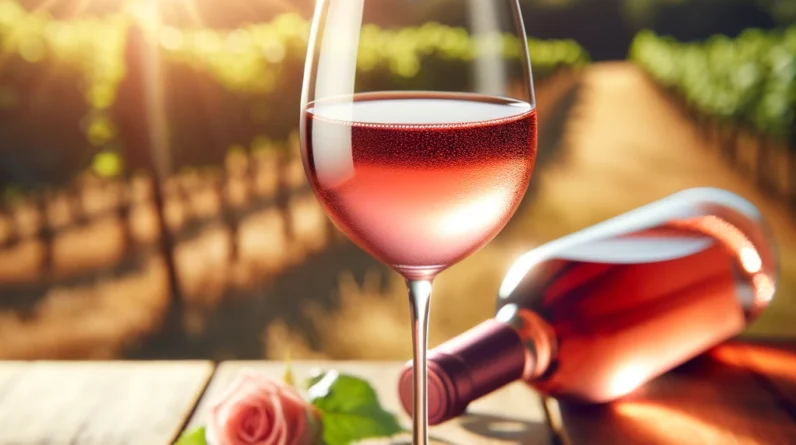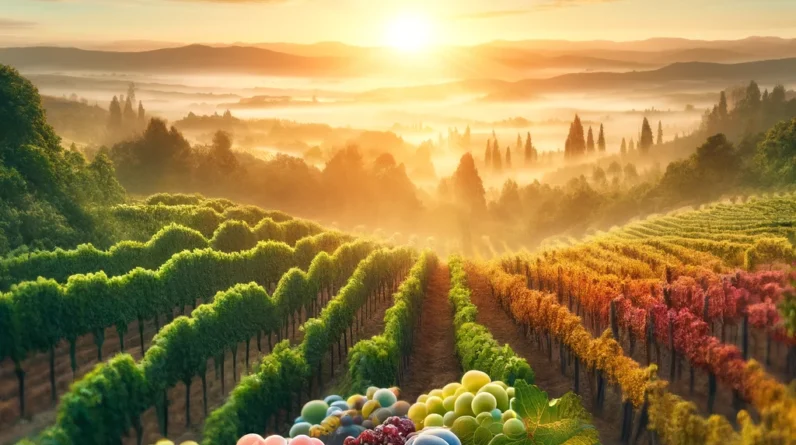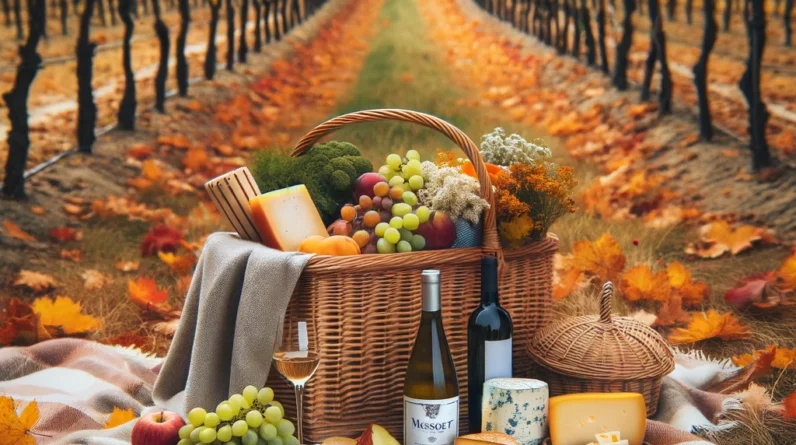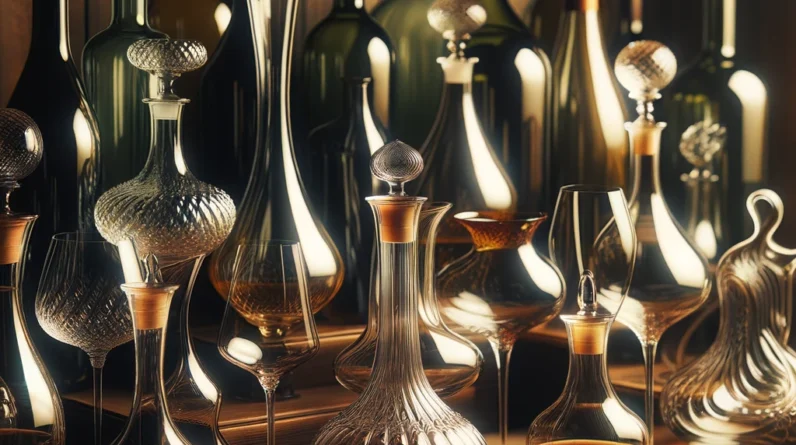
Ever sipped a wine that made your mouth feel like you just took a bite of super dark chocolate?
That’s tannins for you.
This mysterious component in wine is a real game-changer.
Tannins come from the grape’s very heart – its stems, seeds, and skins.
But what’s all the fuss about? Let’s dive in.
Understanding Tannins
Tannins, you see, come from a variety of sources.
Grape stems, seeds, skins, and even oak barrels when wine is aged.
Picture tannins as tea leaves.
The longer they steep, the stronger the brew.
More contact means more tannin in your wine.
Ever felt a wine dry out your mouth?
That’s tannins at work.
Especially on the front and middle of your tongue. It’s like a mini tug-of-war inside your mouth.
The Love-Hate Relationship
Tannic wines?
They split the crowd.
While some wine enthusiasts wear their love for them as a badge of honor, others tread lightly.
Regardless of where you stand, knowing your wine’s tannin level can shape your entire drinking experience.
Showcasing Tannic Wine Varieties

Nebbiolo
Italy cherishes Nebbiolo.
If patience was a wine, it’d be this.
This grape has a bold nature, but give it time.
The reward? A taste that’s truly unforgettable.
Heralded as the “King” of red wines in Italy, Nebbiolo is an enigma.
At first glance, its gentle garnet and orange hues might lull you into thinking it’s a mild wine.
But be warned, a sip of this wine is a gustatory explosion!
Its high acid, alcohol, and tannin content make Nebbiolo a powerful grape that never fails to make a lasting impression.
Found predominantly in the Piedmont region, often dubbed the “Burgundy of Italy”, this grape thrives in climates similar to its native habitat.
With a pronounced acidity and rich, earthy flavors, Nebbiolo from the subregions of Barolo and Barbaresco is particularly sought after.
The gripping tannins in this wine are unmistakable, often serving as a telltale sign in blind tastings.
Cabernet Sauvignon
This one’s a global superstar.
Known far and wide, Cabernet is tannin-rich by nature.
No wonder it pairs so well with hearty meals.

When one thinks of classic, bold red wines, Cabernet Sauvignon often takes the limelight.
Rooted in the prestigious soils of Bordeaux, France, this grape varietal has journeyed across the globe, leaving an indelible mark on wine landscapes from Chile’s mountainous terrains to the sun-drenched valleys of California and the rugged beauty of Australia’s outback vineyards.
But what is it about Cabernet Sauvignon that makes it so universally beloved and unmistakable?
When you’re sipping a Cabernet Sauvignon, the unmistakable mouth-drying sensation that might catch you off guard is courtesy of its medium-to-high tannin content.
Tannins have this unique knack of tangling with the proteins in our saliva, leading to that astringent feel on the palate.
Over time, something magical happens.
As Cabernet Sauvignon wines age, their once dominant tannins mellow down, becoming less pronounced and gentler.
It’s akin to wine gracefully maturing, shedding its youthful vigor but gaining elegance.
The dance between tannins and flavor is a mesmerizing one.
Winemakers, with their masterful techniques, can summon a medley of fruity and earthy undertones in Cabernet Sauvignon.
So, while you might be taken by its robust structure, don’t be surprised if hints of blackberry, plum, or even green bell pepper tease your senses.
In essence, Cabernet Sauvignon is not just a wine; it’s an experience.
A testament to how nature’s bounty, combined with human artistry, can create something truly memorable.
Best Cabernet Sauvignon glasses?
Syrah
Oh, the chameleon Syrah!
It can be airy or dense.
Depending on where it’s from, its tannic tones vary.
California? Bold. France? Equally impressive.

Dive into the world of red wines and soon enough, you’ll encounter the enchanting and multifaceted Syrah.
Also going by the moniker ‘Shiraz’ in some regions, this grape varietal has carved a niche for itself with its unmistakably rich tannin structure.
But, like any great story, the tale of Syrah is one of diversity, depth, and delightful surprises.
At its heart, both Syrah and Shiraz carry a medium-plus to high tannin presence.
But the beauty lies in the details:
The Texture
Syrah’s tannins are often described as fine and impeccably balanced, particularly when the wine hails from the old world.
These tannins don’t overpower; instead, they elegantly weave into the wine’s overall profile, creating a harmonious sip.
The Contrast
The fascinating thing about this grape varietal is the varied tannin experience it offers based on its origin.
Take a Shiraz from the renowned Barossa Valley or a Syrah from the sun-kissed vineyards of Paso Robles.
What greets your palate is a bold, juicy tannin structure – it’s robust, it’s vibrant, and it’s unapologetically flavorful.
The Elegance
Now, switch gears and indulge in a French Syrah.
The experience is transformative.
The tannins here are more subdued, refined, almost like they’ve been crafted with a feathered touch.
It’s a dance of elegance, where the wine whispers its depth instead of shouting it.
In essence, Syrah, or Shiraz if you will, isn’t just a grape varietal; it’s a journey.
A journey that showcases the marvelous impact of terroir on taste, reminding us that wine, much like life, is beautifully unpredictable.
Monastrell
Earthy, strong, and called by many names across the world.
Whether in Spain’s Jumilla or California’s Central Coast, it’s a wine with a robust personality.

The Monastic Origins
Ever wondered about the roots of Monastrell?
Well, its very name provides a clue.
Derived from the term “monasterio” (which translates to ‘monastery’), there’s strong evidence suggesting that the grape variety was initially cultivated by the ever-diligent monks.
These spiritual caretakers, amidst their chants and prayers, might have nurtured this variety, creating the foundation for the wine legacy it now enjoys.
The French Connection
As you sip on a Monastrell, know that you’re also sipping on what the French fondly call ‘Mourvèdre’.
Yes, the two are identical twins, separated by geographical borders but united by taste.
However, their identity is deeply intertwined with their terroir.
While Monastrell basks in the Spanish sun, Mourvèdre graces the vineyards of France, playing a pivotal role in iconic appellation wines.
Think Châteauneuf-du-Pape or the vibrant Côtes du Rhône, and you’ll find traces of this grape enriching the blend.
A Sun Worshipper
The Monastrell grape isn’t your average variety; it’s a bit of a diva, to be honest.
It craves the warm embrace of the sun, yearns for a consistent water supply, and blossoms in the Mediterranean climate.
It’s no wonder then that it ripens rather late, often playing hard to get with its yields.
Flavor and Pairings
When you pour yourself a glass of Monastrell, expect a spectacle.
Its color? Dark, almost mysterious.
Its profile? Bold tannins, with an alcohol level that matches its intensity.
And the aromas? You’ll be greeted with a lush bouquet of blackberries, a hint of earth, and a touch of the wild.
Additionally, Monastrell finds a harmonious partner in the Bobal grape, often blended together to produce a symphony of flavors.
In essence, Monastrell isn’t just a wine; it’s an experience.
It’s a journey from the Spanish vineyards, carried by monks, crossing borders into France, and finally finding its way into your glass, with tales of sunshine, soil, and spirituality.
Cheers to that!
Trying to explore wine aromas? The wine aroma wheel might help!
Sangiovese
When in Italy, do as the Italians do.
Pair your rich food with Sangiovese.
Why? Its tannic character makes it a match made in culinary heaven.

Ever had the pleasure of sipping on a sumptuous Chianti?
If the answer is a resounding ‘yes,’ then you’ve been serenaded by the enchanting Sangiovese.
This grape is nothing short of Tuscany’s crowning glory.
Not just the heart and soul behind Chianti and Chianti Classico, Sangiovese is also the prodigious force behind the revered Brunello di Montalcino, often dubbed ‘The King’ of Tuscan wines.
While Sangiovese does have a tannin range that skews from medium-plus to high, it never overshadows the wine’s inherent acidity.
So, when you’re sipping on a Sangiovese, more often than not, its vivacious acidity will take center stage, dancing gracefully with the tannin undertones.
Montepulciano
Imagine sipping on flavors of plum and tomato.
That’s Montepulciano for you.
A wine that stands tall, with or without food.

Dive into Italy’s treasure trove of wines, and you’ll unearth the marvel that is Montepulciano.
Italy, known for its alluring landscapes and culinary masterpieces, boasts an equally impressive wine heritage.
And within that rich tapestry, Montepulciano gleams like a hidden gem, waiting to be discovered and savored.
Italy’s Pride
Second only in prominence to its sibling grape, Sangiovese, Montepulciano firmly holds its ground as one of Italy’s most cherished red grape varieties.
Sprawling across the heart of Italy, it finds its prime territory in central and southern regions.
But the region that truly wears the Montepulciano crown is Abruzzo, giving the world the famed “Montepulciano d’Abruzzo” label.
Sensory Delights
A glass of Montepulciano is like an Italian opera for your senses.
Visually, its deep purple hue captures attention.
On the palate, its soft tannins grace your taste buds, offering a rustic and authentic Italian wine experience.
The depth of this wine isn’t just in its color but also in its potential to evolve.
Top-tier Montepulciano wines, when aged meticulously for four, five, or even more years, transform.
They shed their youthful exuberance, maturing into complex, layered masterpieces where every sip tells a story.
In essence, Montepulciano is Italy’s gift to the wine world.
It’s a tale of regions, a play of names, and most importantly, a symphony of flavors and textures.
So, the next time you’re looking for a classic Italian red, let Montepulciano serenade you. Saluti!
Malbec
Malbec has two faces.
One’s soft and friendly, the other?
Bold and high-end, especially from Argentina.

While many might be quick to hail Malbec as Argentina’s gift to the wine world, its roots actually trace back to France.
Originally one of the six essential varieties employed in Bordeaux blending, today it takes a backseat in its native land.
But in the sun-kissed landscapes of Argentina, Malbec truly comes into its own.
When you’re looking for a wine that’s a hit at dinners, Malbec is your trusty companion.
With its velvety embrace and a structure that holds its own, it can win over both the connoisseur and the casual sipper.
A couple of must-knows when discussing Malbec:
Mendoza, Argentina, is a name you’ll hear often when seeking the best Malbecs.
It’s a region where the grape thrives, delivering some of the most sought-after bottles.
At its heart, Malbec is all about dark fruits.
However, those cultivated at higher elevations surprise with delightful red fruit undertones.
There’s often a smoky quality to Malbec, a nuance that adds to its allure.
Pairing? Think hearty dinners, and you’re on the right track.
Although versatile with many heavy dishes, Malbec shines brightest with red meat.
A juicy burger and a glass of Malbec could be the pairing you never knew you needed!
While Malbec is celebrated for its velvety texture, its tannin levels can sometimes veer into the medium-plus range, making each bottle a unique experience.
Looking for the universal red wine glass?
Tannins and Health
Here’s some food (or should we say, wine) for thought.
Some studies suggest tannins might have health benefits.
But, as with everything, moderation is key.
Embrace the world of tannin-rich wines.
Their depth, their texture, their audacity.
Remember, the world of wine is vast.
Let tannins be your compass.
Why not challenge your palate?
Taste, compare, and relish the spectrum of tannic wines.
Dive into bold flavors and let every sip tell a story.
FAQ
- What are tannins in wine?
- Tannins are naturally occurring compounds found in wine, sourced mainly from grapes and oak barrels.
- Do all red wines have tannins?
- Most red wines do, but the levels vary.
The winemaking process also influences tannin levels.
- Most red wines do, but the levels vary.
- Can you feel tannins in white wines?
- Rarely. They’re mostly in reds due to prolonged grape skin contact.
- Are tannins bad for health?
- In moderation, tannins might even offer health benefits.
But always drink responsibly.
- In moderation, tannins might even offer health benefits.
- How can I reduce wine’s tannic taste?
- Aging softens tannins.
If it’s too strong, let the wine breathe a bit before sipping.
- Aging softens tannins.







